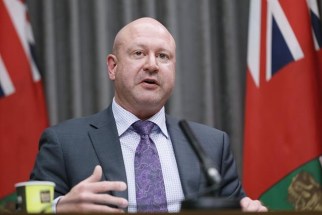Questions remain regarding RCMP response
Read this article for free:
or
Already have an account? Log in here »
To continue reading, please subscribe:
Monthly Digital Subscription
$1 per week for 24 weeks*
- Enjoy unlimited reading on winnipegfreepress.com
- Read the E-Edition, our digital replica newspaper
- Access News Break, our award-winning app
- Play interactive puzzles
*Billed as $4 plus GST every four weeks. Offer only available to new and qualified returning subscribers. Cancel any time.
Read unlimited articles for free today:
or
Already have an account? Log in here »
Hey there, time traveller!
This article was published 23/04/2020 (1744 days ago), so information in it may no longer be current.
Canadians have been opening their hearts to grieving Nova Scotians in the wake of a murderous weekend rampage by a gunman that left 22 people dead.
But residents of the Maritime province deserve more than the thoughts and prayers of a sympathetic nation — they deserve answers.
They deserve to know how it is possible for a lone gunman, wearing an authentic police uniform and, at times, driving a mock-up RCMP cruiser, to travel a nearly 100-kilometre stretch of central and northern Nova Scotia — leaving behind 16 grisly crime scenes — while evading capture for 12 hours before being shot by police.

RCMP have acknowledged the 51-year-old shooter eluded pursuers in part because he was impersonating an RCMP officer, but that alone fails to adequately explain how he remained on the loose for for so long.
More pointedly, Nova Scotians — and all Canadians — need to be told why RCMP, who lost one of their own in the carnage, did not use every tool in their arsenal to warn citizens along the killer’s route that their lives were in peril.
While the horror was unfolding, RCMP issued warnings about the attacker on Twitter and Facebook, but failed to order a public emergency alert that automatically pops up on all smartphones and televisions — even though the provincial alert system had been used to advise people to maintain physical distancing because of COVID-19.
On Wednesday, Chief Supt. Chris Leather attempted to defend the RCMP’s response, insisting that social-media bulletins were effective in getting information to media outlets which then broadcast them more widely, and attributing the delay in issuing an emergency alert to “chain of command” issues.
“You can appreciate that a series of phone calls had to be made to find the officer in charge that evening, and to speak to the serious-incident commander to have the conversation about the issuing of a message,” Mr. Leather offered.
On the contrary, it’s probably safer to assume most Nova Scotians do not “appreciate” such an explanation.
The failure to order an alert for Nova Scotians became even more galling when the U.S. Consulate in Halifax confirmed U.S. citizens in the province were sent an additional e-mailed warning based on information in RCMP tweets.
“It is our protocol — when emergencies occur — to alert U.S. citizens in the area,” said Marcia R. Seitz-Ehler, a spokesperson for the U.S. Consulate General.
Nova Scotia’s emergency measures team reportedly reached out to police numerous times about sending an alert, but RCMP did not request one. Mr. Leather said the force was in the process of preparing an alert when the gunman was located and shot.
“I would say (with) the benefit of hindsight, the depth and breadth of this should have been communicated more widely with a number of our agencies,” said Premier Stephen McNeil.
That is clearly the view of Nick Beaton, whose wife was among the 22 victims. He said an alert — like the one Nova Scotians received about physical distancing — could have saved lives.
“I would not have let my wife leave (for work) … if I had that broadcast come across, that he was on the loose and he was driving an RCMP vehicle,” he said.
Prime Minister Justin Trudeau has promised “important questions” — including how the families of victims might have been warned earlier — will be addressed through an investigation, expected to take months.
In the meantime, a nation’s thoughts and prayers can offer some measure of comfort in the aftermath of this unspeakable tragedy — but only honest answers to hard questions can help save lives in the future.






